A Taste of History
The roots of Hanoi coffee go back to the French colonial period, when coffee plants were first introduced to northern Vietnam in the late 19th century. Over time, locals adapted French brewing techniques and added their own touches, creating a distinctive style that is both rich and innovative. The addition of sweetened condensed milk and later egg yolks transformed simple coffee into a cultural icon. Today, every cup you drink is a nod to the city’s layered history, a mix of French influence and Vietnamese ingenuity.
Why Hanoi Coffee Culture Matters
Coffee in Hanoi is more than a beverage; it’s a reflection of the city’s history, creativity, and community. Every cup, from the iconic egg coffee to the ubiquitous iced milk coffee, connects visitors to local traditions. It’s a ritual that slows life down, encourages conversation, and celebrates everyday moments.
By immersing yourself in Hanoi coffee culture, you not only taste delicious coffee but also understand a key part of the city’s identity. From the bustling streets to quiet alleyways, coffee serves as a bridge between past and present, locals and travelers.
Iconic Coffee Styles in Hanoi
Egg Coffee (Cà Phê Trứng)

Arguably the most famous of Hanoi’s coffee creations, egg coffee is a must-try. Invented in the 1940s at Giang Café, it combines strong, aromatic coffee with a creamy, frothy egg yolk foam. The result is rich, velvety, and slightly sweet—a perfect balance of flavors. Served warm in a small cup, egg coffee is more than just a drink; it’s a culinary experience that embodies Hanoi coffee culture. Many visitors enjoy sitting in the café for hours, sipping slowly while soaking in the historic atmosphere.
Black Coffee with Condensed Milk (Cà Phê Sữa Đá)
 Iced coffee with condensed milk is the classic choice for locals and travelers alike. The strong, bitter coffee contrasts beautifully with the sweet, creamy milk, creating a refreshing and energizing beverage. Whether enjoyed on a hot afternoon or as a quick pick-me-up during a city stroll, this simple drink is an essential part of Hanoi coffee culture. You’ll find it at almost every street corner, from small plastic-stool cafés to trendy modern coffee shops.
Iced coffee with condensed milk is the classic choice for locals and travelers alike. The strong, bitter coffee contrasts beautifully with the sweet, creamy milk, creating a refreshing and energizing beverage. Whether enjoyed on a hot afternoon or as a quick pick-me-up during a city stroll, this simple drink is an essential part of Hanoi coffee culture. You’ll find it at almost every street corner, from small plastic-stool cafés to trendy modern coffee shops.
Weasel Coffee (Cà Phê Chồn)
 For the adventurous, weasel coffee is a rare specialty made from beans that have passed through civets. Known for its smooth, unique flavor, it’s often considered a luxury drink. While expensive, trying even a small cup allows visitors to experience a distinct side of Hanoi coffee culture, highlighting the city’s creativity and willingness to experiment with coffee flavors.
For the adventurous, weasel coffee is a rare specialty made from beans that have passed through civets. Known for its smooth, unique flavor, it’s often considered a luxury drink. While expensive, trying even a small cup allows visitors to experience a distinct side of Hanoi coffee culture, highlighting the city’s creativity and willingness to experiment with coffee flavors.
Hanoi Cafés: More Than Just Coffee
Hanoi’s cafés are not just places to grab a drink—they are cultural spaces. Many cafés feature terraces overlooking bustling streets, or quiet corners tucked away in serene alleys. Locals often spend hours here, chatting, reading, or working, making coffee-drinking a social and leisurely activity rather than a quick routine.
Coffee and Social Life
Street-side cafés with low plastic stools are iconic in Hanoi. It’s common to see friends gathered, students studying, and travelers observing the daily rhythms of the city—all while enjoying a cup of Hanoi coffee. The casual atmosphere, combined with the city’s welcoming vibe, makes coffee a social experience deeply embedded in local life.
Modern Cafés for Work and Relaxation
In recent years, Hanoi has seen a rise in modern cafés that cater to digital nomads and young travelers. With cozy interiors, fast Wi-Fi, and a wide variety of coffee options, these cafés offer a perfect blend of tradition and modernity. Here, visitors can enjoy specialty drinks, immerse themselves in Hanoi coffee culture, and even work or study while soaking in the city’s vibrant café scene.
Conclusion
Exploring Hanoi coffee culture is a journey that delights the senses and connects you to the city’s soul. From traditional egg coffee to modern cafés, each cup tells a story of history, innovation, and social life. To fully enjoy your coffee adventure, stay close to the city’s vibrant coffee spots.






